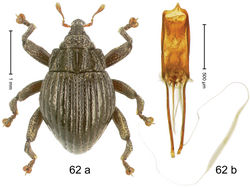Trigonopterus plicicollis
| Notice: | This page is derived from the original publication listed below, whose author(s) should always be credited. Further contributors may edit and improve the content of this page and, consequently, need to be credited as well (see page history). Any assessment of factual correctness requires a careful review of the original article as well as of subsequent contributions.
If you are uncertain whether your planned contribution is correct or not, we suggest that you use the associated discussion page instead of editing the page directly. This page should be cited as follows (rationale):
Citation formats to copy and paste
BibTeX: @article{Riedel2013ZooKeys280, RIS/ Endnote: TY - JOUR Wikipedia/ Citizendium: <ref name="Riedel2013ZooKeys280">{{Citation See also the citation download page at the journal. |
Ordo: Coleoptera
Familia: Curculionidae
Genus: Trigonopterus
Name
Trigonopterus plicicollis Riedel sp. n. – Wikispecies link – ZooBank link – Pensoft Profile
Diagnostic description
Holotype, male (Fig. 62a). Length 2.75 mm. Color black; legs deep ferruginous, antenna light ferruginous. Body in dorsal aspect and in profile with distinct constriction between pronotum and elytron. Rostrum in basal half with 3 ridges posteriorly continued to forehead; furrows each with 1 row of mesad directed setae; epistome weakly swollen, with transverse ridge. Pronotum deeply sculptured; with marked subapical constriction, apical collar with coarse punctures; disk with glabrous median ridge, on each side with additional three highly elevated coarsely punctate ridges; sides with oblique wrinkles and deep punctures. Elytra with striae deeply incised, towards sides with interspersed punctures; intervals costate, subglabrous, with sparse small punctures and wrinkles; apex extended ventrad, slightly beak-shaped. Femora edentate. Metafemur with denticulate dorsoposterior edge, subapically without stridulatory patch. Aedeagus (Fig. 62b) apically with submedian tooth shifted to the left; body at middle with broad depression visible in lateral aspect; transfer apparatus flagelliform, shorter than body, pointing basad; ductus ejaculatorius with bulbus. Intraspecific variation. Length 2.10–2.75 mm. Female rostrum in apical half dorsally flattened, subglabrous, with sparse punctures and lateral furrows; epistome simple.
Material examined
Holotype (MZB): ARC0543 (EMBL # FN429249), WEST NEW GUINEA, Jayapura Reg., Cyclops Mts, Sentani, S02°31.683', E140°30.281', 960 m, 21-XI-2007, sifted. Paratypes (ARC, SMNK, ZSM): WEST NEW GUINEA, Jayapura Reg., Cyclops Mts, Sentani: 6 exx, same data as holotype; 2 exx, ARC0539 (EMBL # FN429245), ARC0540 (EMBL # FN429246), S02°31.594', E140°30.407', 1065 m, 21-XI-2007, sifted; 1 ex, 700 m, 22-XII-2004; 3 exx, 1000 m, 23-XII-2004, sifted; 1 ex, 1320 m, 23-XII-2004, sifted; 4 exx, 1100 m, 23-XII-2004, sifted.
Distribution
Jayapura Reg. (Cyclops Mts). Elevation: 960–1320 m.
Biology
Sifted from leaf litter in primary forest.
Etymology
This epithet is based on a combination of the Latin nouns plica (fold) and collum (neck, pronotum) and refers to the surface of the pronotum.
Notes
Trigonopterus plicicollis Riedel, sp. n. was coded as “Trigonopterus sp. 32” by Riedel et al. (2010)[1] and Tänzler et al. (2012)[2], respectively “Trigonopterus spaf” in the EMBL/GenBank/DDBJ databases.
Original Description
- Riedel, A; Sagata, K; Surbakti, S; Rene Tänzler, ; Michael Balke, ; 2013: One hundred and one new species of Trigonopterus weevils from New Guinea ZooKeys, 280: 1-150. doi
Other References
- ↑ Riedel A, Daawia D, Balke M (2010) Deep cox1 divergence and hyperdiversity of Trigonopterus weevils in a New Guinea mountain range (Coleoptera, Curculionidae). Zoologica Scripta, 39 (1): 63-74. doi: 10.1111/j.1463-6409.2009.00404.x
- ↑ Tänzler R, Sagata K, Surbakti S, Balke M, Riedel A (2012) DNA barcoding for community ecology - how to tackle a hyperdiverse, mostly undescribed Melanesian fauna. PLoS ONE 7 (1): e28832. doi: 10.1371/journal.pone.0028832
